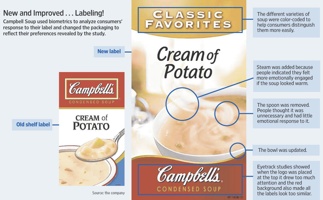Future Now
The IFTF Blog
Neuromarketing and soup labels
Several weeks ago, I posted about a possible resurgence in neuromarketing, using brain imaging and other physiological monitoring to directly measure consumer preference and the effectiveness of advertisements. Now, Campbell's Soup boasts that they've used biometrics, such as measurements of galvanic skin response (moisture) and heart rate, to get a bead on consumer response to various designs. (Disclosure: Campbell's Soup is an IFTF client.) The company partnered with Innerscope Research, a neuromarketing firm, and others on the two year research effort that combined the biometric data with deep surveys about Campbell's Soup as a brand, and the experience of eating soup. Warhol would have had a field day with this. From the Wall Street Journal (click the infographic to see it larger):
Robert Woodard, Campbell's vice president of global consumer and customer insights, says the traditional interview had limited usefulness because people's words didn't fully capture their unconscious responses. He says Campbell needed approaches that would help it understand the neurological and bodily responses to an ad rather than how people thought they'd reacted...
(In the Innerscope partnership,) researchers interviewed about 40 people at their homes and later in grocery stores. The team also clipped small video cameras to the 40 testers at eye level and had them later watch tape of themselves shopping for soup. Vests that the testers wore captured skin-moisture levels, heart rate, depth and pace of breathing, and posture. Sensors attached to the video monitor tracked eye movements and pupil width.
The researchers found that warmth and other positive attributes people associated with Campbell's soup at home evaporated when they faced store shelves.
Typically, consumers show simultaneous blips in most of their biological metrics when they decide to buy something. These indicate the emotional reward they feel for making a choice and may help drive future purchases, (Innerscope founder Carl) Marci says.
But the array of condensed soups so overwhelmed many participants that they would quickly scan the category and select soups while evidencing little biometric response.
The people who spent more time exploring varieties showed more and bigger simultaneous spikes in biometrics—and tended to put more soup cans in their baskets.
The Campbell team figured it could boost sales by triggering more emotional responses in stores and prompting more people to focus on more soups.
Another round of research showed that Campbell's large logo at the top of shelf displays draws more attention than necessary. At first glance, the logo's bright red background makes all varieties of soups—from the classic chicken noodle to the jazzier Italian Wedding Soup—seem to blend together, the company learned.
In interviews, participants also said the soup pictured on the can and shelf labels didn't look warm. And the big spoon holding a sample of soup on each label provoked little emotional response.
"The Emotional Quotient of Soup Shopping"




